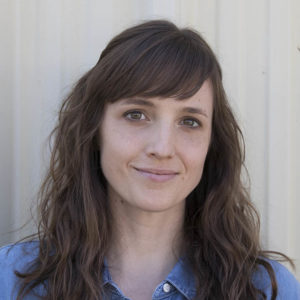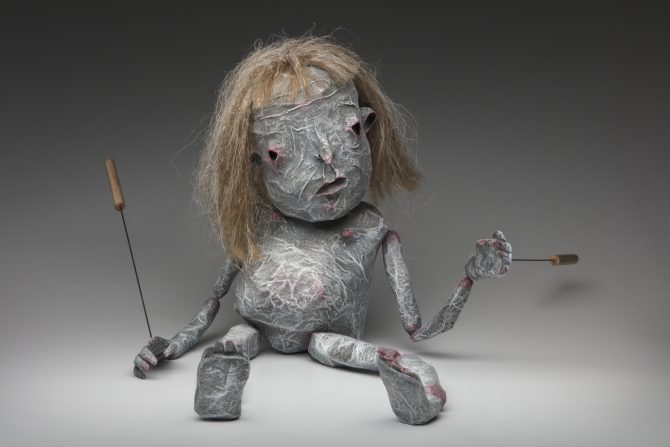In April, my kids and I were lucky enough to see a performance of Ric Averill’s The Runaway Orchestra at the Lawrence Arts Center. Among the play’s many charms were giant paper mache heads worn by actors portraying various characters. These puppets were created in a special course taught by the Arts Center’s 2018-2019 printmaker artist-in-residence, Johanna Winters, who recently took the time to answer a few questions about her life and work.
DC: When did you realize you wanted to be an artist, and did you have any favorite creators you looked up to when you were a kid? Any favorite books?
JW: I entered the artist trajectory a bit late in my formative years. I didn’t fully consider myself an artist until I began graduate school in 2015. Though I studied art in college, I was equally serious about developing into an elite athlete, and after graduating I pursued a professional cross country skiing career. When I decided to part with this lifestyle I became invested in making creative work again, but it certainly took some time to build up my confidence as an artist.
As a kid I loved the worlds created by authors and artists like Tomie dePaola, Richard Scarry, the Berenstains, Tim Burton, and the cartoonist Gary Larson. (I developed a morning ritual of reading the daily comics in the newspaper while scarfing down two bowls of cereal.) Also, my older sister was in a lot of productions at the Children’s Theatre Company in Minneapolis where we grew up, and I spent many afternoons backstage hanging out with cast members and observing rehearsals. This behind-the-scenes view was my first glimpse into how these invented worlds of theatre were constructed.
Richard Scarry's Cars and Trucks and Things That Go
The Berenstain Bears and the Trouble With Grownups
Minneapolis also has an active puppet theatre community, and I distinctly remember the first time I saw a performance at the Open Eye Figure Theatre in my early twenties. I recall thinking I had never seen anything like it before, and how much I desired to make work like this. I was recently invited to perform my own puppet-figure work at Open Eye this summer, which I never could’ve imagined ten years ago!
DC: How have the athletic life and the art life related to one another in your experience? Did you have a chance to do any cross country skiing here in Lawrence with all the snow we had last winter?
JW: My skis are in storage at my parent’s house in Minneapolis, and unfortunately I haven’t had the opportunity to use them in a while. I definitely miss the solitude of skiing in the north woods after a fresh snowfall.
I think there’s a parallel between training for a sport like cross country skiing and making work in the studio. Both are endurance efforts, and require and an immense sense of discipline and a trust in the process. You have to be comfortable with the uncertainty of the end result.
I also think the competitive spirit that I cultivated as an athlete has carried over into my creative pursuits, which can be a good motivator if kept in check. And sometimes I still catch myself wanting conclusive, unambiguous feedback about my work – ‘is this work good, is this work no good?’ – in the way that my race results were decisive. I always knew whether I had a good race or not, but I don’t always know if my work is compelling. Nowadays, though, I’m much more interested in whether my work invites curiosity and opens up more inquiries than definitive answers.
DC: Libraries nowadays strive to be incubators for the arts. Have they played a role in your development as an artist?
JW: Attending graduate school to pursue a Master of Fine Arts allowed me to establish a disciplined studio practice and a basis for research and critical thinking. I was introduced to so much theory and poetry and writing that I wouldn’t have discovered on my own, and this influx of new knowledge propelled me towards making more intentional work.
I most definitely used the university’s library as a resource while in school, and I loved that graduate students were allowed to keep books checked out for a ridiculous amount of time. Whenever I move to a new city I get a library card and use it to access books or films from my evolving list of ‘items I intend to consume for research and/or pleasure.’ Some current items on this list are Laurie Anderson’s film Heart of a Dog, Umberto Eco’s On Ugliness, Eileen Myles’ I Must be Living Twice, and Jos Charles’ Feeld.
DC: I think of paper mache as the most democratic of art forms—most people have tried it at one time or another in their lives, often as children with a parent, or in connection with a Halloween costume. How did you get started with paper mache?
JW: I love how accessible and delightfully lowbrow paper mache is in terms of materials, cost, and technique. I recall some sloppy interactions with newspaper strips and glutenous sludge as a kid, but I didn’t hone my ‘craft’ until about four years ago when I had the opportunity to study with a puppeteer and playwright in Minneapolis. He showed me some basic marionette-building skills using paper mache and I’ve been constructing puppets with it since then.
DC: What attracts you to puppetry as a medium?
JW: Puppetry is a seductive medium. When we look at an animated puppet, we detect something familiar and recognizable in the object’s near-humanness. At the same time, we notice something decidedly un-human or repelling about these forms. There’s a competing desire to look closer and look away, and within this tension is the potential for compelling storytelling.
As I’ve shifted more towards performance as an art medium, I’ve also found that puppetry acts as a bit of a shield for me – I can hide behind a puppet (or under a mask or behind a screen) which makes me feel less vulnerable. Recently I’ve been working towards shedding this discomfort, and fully engaging in the work as a performer. It makes the work stronger if I’m not feeling sheepish about it!
DC: What would you like people to know about ENDLNG, your upcoming solo show (May 31-June 22, 2019) at the Lawrence Arts Center?
JW: ENDLNG is a puppet-figure performance, installation, and sound piece that proposes a narrative in which female desire and agency demand to be witnessed. The show features a puppet – the ENDLNG – who confronts her longing and disappointment as she’s tended to by her puppeteer minders. The show also includes shadow puppetry, sculpture, and a series of hand-printed works on paper. ENDLNG will be performed live on May 31, 7:00 + 8:00pm, Thursday June 6, 7:00 + 8:00pm, and Saturday June 15, 2:00 + 3:00pm.
All performances are free and open to the public!
If you know a teen who may be yearning to start a paper mache project of their own, register for our Breakfast with Aliens program this summer. On three Wednesday mornings in June, LPL librarian and practitioner of paper mache, Dan Coleman, will guide kids through the process of creating their own alien (and eating a variety of yummy breakfast foods).
–Dan Coleman is a Collection Development Librarian at Lawrence Public Library.




Add a comment to: Invented Worlds: An Interview with Johanna Winters